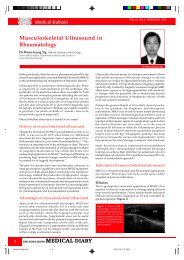Dermatology - 香港醫學組織聯會
Dermatology - 香港醫學組織聯會
Dermatology - 香港醫學組織聯會
You also want an ePaper? Increase the reach of your titles
YUMPU automatically turns print PDFs into web optimized ePapers that Google loves.
VOL.15 NO.11 NOVEMBER 2010<br />
Recent Advances in Cosmetic <strong>Dermatology</strong><br />
in Asians<br />
Dr. Henry HL CHAN<br />
MD(London), PhD(HK), FRCP(London, Edinburgh, Glasgow), FHKCP, FHKAM(Medicine)<br />
Honorary Professor, LKS Faculty of Medicine, The University of Hong Kong<br />
Visiting Scientist, Wellman Center of Photomedicine, Harvard Medical School, Boston, USA<br />
Specialist in <strong>Dermatology</strong><br />
Abstract<br />
Asians differ from Caucasians as photoageing tends<br />
to present with pigmentary changes as the main issue.<br />
Furthermore, with a higher epidermal melanin context,<br />
there is a greater risk of complications especially postinflammatory<br />
hyperpigmentation and such high<br />
epidermal melanin context also acts as a competing<br />
chromophobe for the underlying target. In this review<br />
article, recent advances in the area of skin rejuvenation<br />
in Asians as well as new technologies for skin tightening<br />
and body contouring will be discussed.<br />
Introduction<br />
The global financial crisis in 2008 did have an impact<br />
to the development of medical devices in cosmetic<br />
dermatology. Many companies merged to reduce<br />
cost and some unfortunately went into bankruptcy<br />
(such as Rhytec-the company that developed<br />
plasma skin rejuvenation technology). Furthermore,<br />
most companies delayed the introduction of new<br />
technologies in such time of uncertainty which also<br />
implies that there are relatively fewer recent advances<br />
in cosmetic dermatology. Nonetheless, there are several<br />
new developments and this article will discuss such<br />
development in the treatment of acquired pigmentary<br />
disorders; fractional resurfacing; non-invasive skin<br />
tightening and body contouring.<br />
Treatment of Acquired Pigmentary<br />
Disorders<br />
Freckles and Lentigo<br />
Many lasers and light sources can be used for the<br />
treatment of freckles and lentigines. Q-switched<br />
(QS) lasers employ quality switching, a technology<br />
that involves the use of an electromagnetic switch to<br />
abruptly stop the laser from passing through the cavity<br />
and when the blockage is then suddenly removed, laser<br />
pulses with extreme short durations (in the nanosecond<br />
range) and high energy (1,000,000 W/cm 2 ) are produced.<br />
QS lasers can be most effective for the treatment of<br />
freckles and lentigines especially in light skin patients.<br />
However, previous studies indicated that postinflammatory<br />
hyperpigmentation (PIH) can occur<br />
among Asians as QS lasers produce excessive tissue<br />
response due to their high energy and therefore resulted<br />
in greater degree of inflammation which in Asians is<br />
translated to a higher risk of PIH 1,2 . To reduce such<br />
Medical Bulletin<br />
Dr. Henry HL CHAN<br />
risk, long pulsed pigment laser and intense pulsed<br />
light source have been used and lower risk of PIH can<br />
be obtained. Recently, the technique of compression<br />
window to empty the blood vessels and in doing so,<br />
reduce the risk of purpura has been advocated 3 . The<br />
purpose is to reduce haemosiderin deposition that<br />
can arise as a result of purpura post-laser treatment.<br />
Haemosiderin deposition can also contribute to the<br />
appearance of post-inflammatory hyperpigmentation in<br />
Asians. More recently, the concept of contrast between<br />
lesional and non-lesional skin in the treatment of<br />
lentigines among skin of colour is introduced. Unlike,<br />
light-skin patients whereby such contrast is great,<br />
complication is uncommon. However, for Asians or skin<br />
of colour when such contrast is low then issues occur<br />
especially when one uses a large spot size device. To<br />
avoid complications with a large spot size device, the<br />
operator has to reduce the fluence and often clinical<br />
efficacy is compromised. If the operator wishes to obtain<br />
better efficacy and push up the fluence, above threshold<br />
injury can take place leading to rather undesirable<br />
effects. Such hypothesis was validated in a recent<br />
retrospective study looking at forty Chinese subjects<br />
with lentigines treated with four different devices 4 . The<br />
long pulsed pigment laser with a compression window<br />
and small spot size achieved the greatest degree of<br />
improvement and least complication (Figure 1).<br />
Figure 1: 1month after 2 monthly treatments with long pulsed<br />
KTP 532nm laser (14J/cm2;2mm;2ms)<br />
Melasma<br />
Treatment of melasma remains the main challenge and<br />
while low fluence large spot size QS 1064nm Nd:YAG<br />
laser, otherwise known as laser toning or laser facial,<br />
had been advocated to be effective in the treatment<br />
of melasma, it is not without adverse effects. A recent<br />
article that has been accepted to be published reported<br />
14 Hong Kong women that developed punctate<br />
depigmentation as a result of frequent treatments<br />
with this laser 5 . Looking at two recent published<br />
articles from Thailand and Korea, the risk of such<br />
complication is about 10% (5 out of 47 patients) after<br />
about 6 treatment sessions when one combined the<br />
29
















